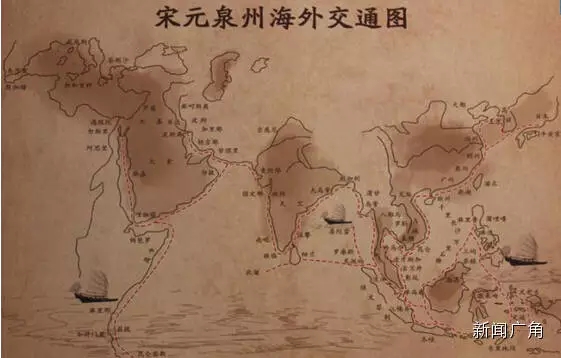丝路资讯
联合国教科文组织解释:泉州为何是海丝极其重要港口?
摘要: 12月10日联合国教科文组织官方网站第一次全面系统大篇幅介绍泉州厚重的历史文化和丰富海丝遗存的文章。泉州海丝专页大篇幅登上联合国教科文官网,非常难得!这是泉州正以一次又一次的国际亮相,为建设21世纪海上丝绸之路先行区加码助力 (现全文刊登如下,感谢泉州黎明大学王强副教授翻译此文) 泉州,海上丝绸之路东段极其重要的港口 Quanzhou: a crucial port along the eastern maritime Silk Roads Locatedon the south-east co ...
12月10日联合国教科文组织官方网站第一次全面系统大篇幅介绍泉州厚重的历史文化和丰富海丝遗存的文章。泉州海丝专页大篇幅登上联合国教科文官网,非常难得!这是泉州正以一次又一次的国际亮相,为建设21世纪海上丝绸之路先行区加码助力
(现全文刊登如下,感谢泉州黎明大学王强副教授翻译此文)

泉州,海上丝绸之路东段极其重要的港口 Quanzhou: a crucial port along the eastern maritime Silk Roads
Locatedon the south-east coast of China,the city of Quanzhouwas one of the most important Chinese ports along the historic Maritime SilkRoads. Known as Zayton (or Zaitun) by traders arriving from the Arab world, theport has welcomed sailors and travellers from many different cultures andreligions as they traversed these routes. Commercial and cultural interactionbetween the city and other regions, particularly around the South Sea,can be dated to as early as the Chinese Southern Dynasties of the 6th centuryAD. Subsequently, the port was one of the four major Chinese ports in use underthe Tang dynasty (618–907 AD) and went on to become the largest port in easternChinaduring the Song dynasty (960-1279 AD) and Yuan dynasty (1271—1368 AD). It wasalso linked with around one hundred other ports along the Maritime Silk Roads,including Madras in India,Siraf in Iran, Muscat in Omanand Zanzibar.From the 10th century, Erythrina variegata trees have been planted around theharbour entrance to welcome and impress sailors with their eye-catching redflowers, and the Chinese name for the plant, Citong(刺桐), is reflected in the city's Arabic nicknameof Zayton.
位于中国东南沿海,泉州是中国古代海上丝绸之路港口之一。这座被阿拉伯世界的贸易商人称之为刺桐港的港口,作为往来于海上丝绸之路航线上极其重要的港口,接纳不同文化与宗教背景航海者与旅行者。泉州与周边地区,尤其是与南海地区之间的商业和文化的交流最早的历史记录是公元6世纪,即中国的南北朝时期。泉州港在唐代(公元618-907年)是中国四大港口之一。这座港口城市在宋代(960-1279AD)和元代(1271-1368AD)成为中国东部最大的港口。泉州刺桐港当时曾与海上丝绸之路沿线一百多个港口有商贸联系,如印度的马德拉斯,伊朗西拉夫港,阿曼的马斯喀特,以及远及非洲坦桑尼亚东北部的桑给巴尔岛。公元10世纪,栽种在港口周边迎接远方航海者的火红刺桐花特别吸引人,泉州港因刺桐花而得名Citong(刺桐港),阿拉伯水手昵称之为Zayton。
联合国教科文组织解释:泉州为何是海丝极其重要港口?
A number of famous medieval explorers, suchas Marco Polo, Friar Odoric of Pordenone, and Ibn Battuta, visitedQuanzhou and wrote descriptions of the port as one of the biggest harbours inthe world, with ships of all sizes and provenances docking and setting sail,and a vibrant market in which merchants from across many different regionsexchanged their wares. It also appears that Marco Polo set off on his missionto accompany a Mongol Princess for her marriage ceremony in Persia (ModernIran) from Quanzhou.
中世纪的几位著名的探险家如马可波罗,弗莱尔Odoric和伊本白图泰都曾到访过泉州,并写下刺桐港是世界上最大的港口的描述。作为各类船舶起航地与停泊地,刺桐港还是一座繁华的商埠,来自不同地区的商人在此交换商品。意大利人马可波罗看来就是从泉州刺桐港出发陪伴蒙古公主远嫁波斯(现在的伊朗)。
This glorious past is attested by severalhistoric sites linked to the maritime Silk Roads in Quanzhou. Shipwrecksexcavated in Quanzhou bay and the South China Sea testify to the prosperity andvibrancy of the port, such as the wreck of a sailing ship with a wooden hull,unearthed in Houzhu Harbor (Quanzhou Bay). This three-mastedocean-going commercial vessel seems to have been originally built in Quanzhouin the 13th century, and at the time of the wreck, was returningfrom South-East Asia loaded with spices,medicines and other merchandise. Additionally, as well as being one of themajor hubs of commerce and exchange along the Maritime Silk Roads, Quanzhou wasa leading centre for shipbuilding and the development of navigationtechnologies during the Song dynasty.
泉州众多与海上丝绸之路相关的历史遗迹见证了泉州港这段辉煌的历史。泉州湾出土的船舶和南海沉船见证泉州港当年的繁荣和兴旺。例如泉州湾后渚港出土的那一艘沉没的木壳帆船的残骸,就是一艘建于13世纪泉州的三杆远洋商船,当时满载香料,药品和其他商品,从东南亚回国后在港口沉没。再则,泉州港作为海上丝绸之路上重要的商业枢纽与交流中心还是宋代最先进的造船和航海技术的中心。
Sailors, merchants and explorers cametogether in Quanzhou from across many different regions of the world, and theircontinual presence in the city contributed to the development of peacefulcoexistence between the many different ethnic and religious groups in the city,including Buddhists, Hindus, Taoists, Nestorians, Manichaeans, Jews, Catholicsand Muslims. This is illustrated by the diversity of historic religious sitesand monuments in the city of Quanzhou. The Kaiyuan temple, withits twin pagoda towers, is one of the oldest Buddhist temples in China, whilstthe Laojun statue, which is the biggest Chinese stone statue of its kind,illustrates the presence of Taoism. The Qingjing Mosque, furthermore, is China's oldestmosque, and stands as a witness to the long-lasting interaction betweenQuanzhou and the Arab-Islamic world. Additionally, the Can An (Thatched Hut)Manichaean temple hosts the only stone statue of the Manichaean prophet, Mani. Furthermore, a number ofcivic monuments such as the stone-beam bridge, Luoyang, and the scenic long bridge, Anping,not only stand as witnesses to the prosperity of the Quanzhou-Zaitun harbour,but also reflect a blend of Chinese and other cultures in their design andarchitecture.
从世界各个不同地区来到泉州港的航海者,商人和探险家,有佛教徒,印度教徒,信奉道教、景教、摩尼教、犹太教、天主教和伊斯兰教的人士,他们居住在这座城市里为不同种族与宗教群体和谐共处的社会发展作出了贡献。从泉州这座城市宗教历史遗址与遗迹多样性可以得到证明。有以双塔作为标志的开元寺是中国最古老的佛教寺院之一;同时也有中国最大的道教老君雕像;作为中国最古老的清真寺的泉州清净寺都是泉州与阿拉伯世界长期交流的见证。另外,泉州晋江草庵供奉着世界仅存的摩尼光佛石像。此外,还有其他民间的古迹,如梁式石桥洛阳古桥,五里长桥安平桥不仅见证了刺桐港的繁荣的见证,也反映了中国和其他文化在设计和建筑上的融合。
In recognitionof the role played by Quanzhou as one of the major ports along the MaritimeSilk Roads, a team from UNESCO visited the city in 1991, as part of theOrganization’s Maritime Silk Road expedition. Over the course of a five daystay, in addition to numerous meetings and discussions between renownedinternational and local Silk Roads experts, UNESCO recommended theestablishment of a Maritime Silk Roads study center in the city.
在认识到泉州在古代海上丝绸之路的历史作用,作为联合国教科文海上丝绸之路考察活动的一部分,1991年联合国教科文组织海上丝绸之路考察队考察了这一个海上丝绸之路沿线重要港口。在泉州五天的考察中,多个著名国际专家与本地专家之间进行多次接触与交流,联合国教科文组织建议在这个城市建立了海上丝绸之路研究中心。
More recently, in commemoration of its historicalimportance along the Maritime Silk Roads, the municipal government of the cityof Quanzhou, in collaboration with the Permanent Delegation of the Peoples'Republic of China to UNESCO, organized an exhibition entitled “Greeting fromQuanzhou”, which took place in the UNESCO Headquarters in Paris, on 14-18October 2014. The exhibition displayed and explained different aspects of thecultural heritage of Quanzhou and highlighted the city's links to the MaritimeSilk Roads. It was inaugurated by a message from UNESCO's Director General, Ms.Irina Bokova, delivered by the Assistant Director General for StrategicPlanning, Mr. Hans D’Orville.
最近,为了纪念泉州在海上丝绸之路的历史重要性,2014年10月14-18日泉州市政府与中国人民共和国常驻教科文组织代表团合作在联合国教科文组织总部举办“中国一日-重返泉州-来自泉州的问候”的展览。展览展示泉州历史文化遗产的各个方面,特别突出展示了泉州与海丝丝绸之路的历史联系。此展会是由联合国教科文组织伊琳娜·博科娃女士总干事发布的消息揭开序幕的,并由联合国教科文组织战略规划助理总干事汉斯·德奥维尔先生发表演讲。
In her message, the Director General underlinedQuanzhou's historic role as the most famous Chinese port along the MaritimeSilk Roads and emphasized the city’s attachment to the sea as the major routefor dialogue and exchange among peoples and cultures. Ms. Bokova alsohighlighted the remarkable cultural heritage of Quanzhou, as illustrated by thecity's presence in a number of different UNESCO heritage lists, including theWorld Heritage and the Intangible Heritage lists.
在联合国教科文组织总干事伊琳娜·博科娃女士撰写的开幕辞中,她强调了泉州作为海上丝绸之路最著名的中国港口的历史地位,以及这座依傍大海的城市对不同民族和文化之间的对话与交流所做的贡献。博科娃女士着重提及泉州举世瞩目的历史文化遗产,包括世界遗产和非物质遗产名录、以及收录进联合国教科文组织名录的历史文化遗产。
Special tribute was paid during the inauguration ceremonyto the former director of UNESCO’s Silk Roadinitiative, Mr. Doudou Diene, both by the UNESCO Director General and theQuanzhou authorities.
在本次展览的开幕仪式上,联合国教科文组织总干事与泉州市特别感谢联合国教科文组织丝绸之路项目前总干事杜杜·迪安先生所作出的贡献。
